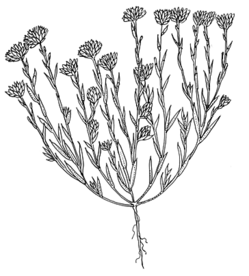
Description: Annual or perennial herbs with glandular and non-glandular short, long or woolly-cobwebby hairs.
Leaves basal and cauline, alternate, sessile or sheathing, entire or slightly crenate.
Compound heads solitary, terminal on long flowering scapes or in leafy corymbs, campanulate or almost hemispherical; involucral bracts in many series, outer much smaller and grading in size inwards, with herbaceous bases, those of the outer bracts reduced, those of the inner bracts long and usually claw-like, all with scarious laminas; receptacle convex, naked, pitted. Florets numerous, mostly bisexual, 5-merous, with a few outer florets female, 3- or 4-merous. Corollas tubular much longer than the involucre. Anthers tailed at the base. Style branches linear with a truncate, papillose apex.
Achenes oblong or falcate, compressed or obscurely 4-angled, slightly narrower at the apex or with a long, slender beak, all similar; pappus of few to many slightly fused bristles; bristles barbellate, or brushlike at the tip; pappus of female florets similar or reduced.
Distribution and occurrence: World: 10 spp., endemic Aust., all States except N.T.
**L. scaber (Benth.) Haegi is very similar to L. elongatus but differing in having bright yellow flowers (as against pale yellow or almost white). The previous record of this species from N.S.W. is not substantiated and there have been no specimens collected in over 100 years. [published as L. scabrus (Benth) Haegi]
Text by J. Everett
Taxon concept:
| | Key to the species | |
| 1 | Involucral bracts ciliate | 2 |
| Involucral bracts entire or lacerate | 6 |
| 2 | Leaves crowded towards the base, strongly sheathing; scapes long and leafless (but with appressed transparent bracts) | Leptorhynchos squamatus |
| Leaves crowded toward the branch tips or scattered, leaf bases sessile or very slightly stem-clasping
Back to 1 | 3 |
| 3 | Pappus bristles of bisexual florets 5 or more | 4 |
| Pappus bristles of bisexual florets 4 or fewer
Back to 2 | 5 |
| 4 | Achenes contracted to a pale beak, one third the achene length; tips of the involucral bracts not reflexed; greenish herb with decumbent radiating stems, ascending distally | Leptorhynchos waitzia |
| Achenes oblong without a narrowed beak; very tips of the involucral bracts reflexed at maturity; much-branched silvery grey woody herb or subshrub
Back to 3 | Leiocarpa panaetioides |
| 5 | Pappus bristles of bisexual florets 4, about equal to the corolla, barbellate in the upper half | Leptorhynchos tetrachaetus |
| Pappus bristles of bisexual florets 1–3, three-quarters the length of the corolla, stiffly plumose in the upper half
Back to 3 | Leptorhynchos baileyi |
| 6 | Achenes with a distinct long slender beak | 7 |
| Achenes oblong or falcate, maybe slightly tapered at the tip but without a distinct beak
Back to 1 | 8 |
| 7 | Surface of the translucent part of the involucral bract is hairless and smooth | Leptorhynchos orientalis |
| Surface of the translucent part of the involuctal bract has a scabridulous surface (minute projections causing a rough surface)
Back to 6 | Leptorhynchos scaber |
| 8 | Involucral bracts obtuse, not extending down the peduncle | Leptorhynchos nitidulus |
| Involucral bracts acute or acuminate, conspicuously extending down the peduncle
Back to 6 | Leptorhynchos elongatus |
|


